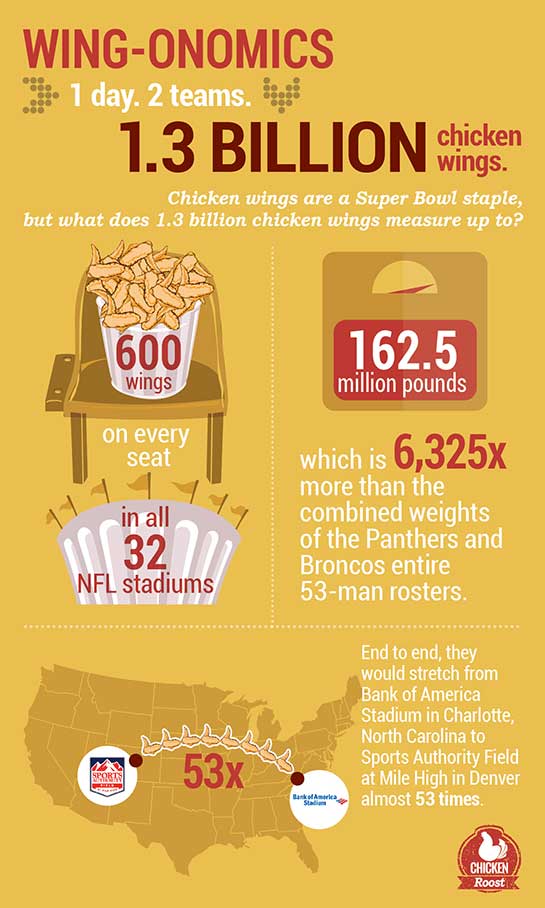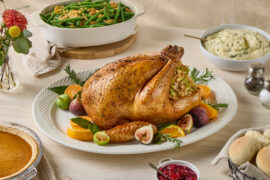With the second biggest eating day of the year after Thanksgiving approaching in the United States – Super Bowl Sunday on February 7 – there’s no greater time for consumption of chicken wings, one of America’s favorite party foods.
 According to the National Chicken Council’s 2016 Wing Report, 1.3 billion wings will be eaten during the weekend leading up to and during Super Bowl 50, as fans watch the Carolina Panthers and Denver Broncos battle for the National Football League (NFL) championship. That figure is up 3%, or 37.5 million wings, from last year’s big game.
According to the National Chicken Council’s 2016 Wing Report, 1.3 billion wings will be eaten during the weekend leading up to and during Super Bowl 50, as fans watch the Carolina Panthers and Denver Broncos battle for the National Football League (NFL) championship. That figure is up 3%, or 37.5 million wings, from last year’s big game.
It comes as no surprise that chicken wings have become a staple on Super Bowl party menus, as Americans’ demand for them continues to soar. Wings recently flew to the top of the rankings of the Today Show’s “Super Bowl Snack Bracket,’ handing a snack smack-down to nachos, guacamole, salsa, chili and other popular menu items.
For those who can’t fathom the scope and volume of so many wings, consider the following:
- 1.3 billion chicken wings is enough for every man, woman and child in the United States to have four wings each.
- If 1.3 billion wings were laid end to end, they would stretch from Bank of America Stadium in Charlotte, North Carolina, to Sports Authority Field at Mile High Stadium in Denver almost 53 times.
- That is enough wings to put more than 600 on every seat in all 32 NFL stadiums (not including London, of course).
- Weighing in at about 162.5 million pounds, 1.3 billion wings weigh 6,325 times more than the combined weights of the Panthers and Broncos entire 52-man rosters.
- If one of the three Power Ball lottery winners spent the lump sum jackpot on chicken wings, he or she could buy about 123 million pounds of wings, or only 76% of the 1.3 billion wings eaten Super Bowl weekend.
- 1.3 billion wings would stretch 10,468 times from the deepest part of the Marianas Trench in the western Pacific Ocean to the surface.
“Any way you measure it, that’s a lot of wings,” said Tom Super, senior vice president of communications for the Washington, DC-headquartered National Chicken Council (NCC).
Where Americans Get their Wings
The NCC estimates that of the wings eaten during the Super Bowl, 75 percent will come from foodservice outlets and 25 percent from retail grocery stores. According to CHD Expert’s foodservice database, Easy2FIND, over 300 new chicken wing restaurants opened in the USA during 2015.
 By CHD’s calculations, the top five chicken wing chains in the United States in terms of number of units and market share are Wingstop (44%), Pizza Hut’s WingStreet (25%), Hurricane Grill & Wings (6%), Wow Café & Wingery (4%), and Wing Zone (4%).
By CHD’s calculations, the top five chicken wing chains in the United States in terms of number of units and market share are Wingstop (44%), Pizza Hut’s WingStreet (25%), Hurricane Grill & Wings (6%), Wow Café & Wingery (4%), and Wing Zone (4%).
As for Buffalo Wild Wings, its 1,100-plus full service restaurants with full bar are classified as a Bar & Grill operations. However be assured there are plenty of wings on the menu.
Chicken wings sold at grocery stores and supermarkets – many of which are distributed in frozen form – skew towards households with three people or more, younger Baby Boomers, Gen Xers and females 35-54, according to IRI FreshLook Household Panel Data. “Each one of these categories presents an attractive target for retailers,” Super noted.
Wing-onomics
The average price (wholesale, not retail) of whole wings is currently about $1.78 per pound, down from around $2 a pound at the same time last year, according to the Daily Northeast Broiler/Fryer Report by the US Department of Agriculture’s Agriculture Marketing Service.
Wing prices traditionally go up in the fourth quarter of the year as restaurants and supermarkets stock up for Super Bowl bashes, and prices usually peak in January during the run-up to the big game.
“A chicken only has two wings. Therefore, the supply of wings is limited by the total number of chickens produced,” Super pointed out.
“Chicken production last year was up around four percent, and USDA is predicting another two-plus percent increase in 2016. So an increase in supply, coupled with exports being down, means there are more wings on the market trying to find a home; and hence, at a lower price.”






